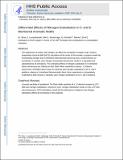| dc.contributor.author | Levandowski, Brian | |
| dc.contributor.author | Abularrage, Nile S | |
| dc.contributor.author | Raines, Ronald T | |
| dc.date.accessioned | 2021-02-19T22:57:35Z | |
| dc.date.available | 2021-02-19T22:57:35Z | |
| dc.date.issued | 2020-03 | |
| dc.date.submitted | 2020-03 | |
| dc.identifier.issn | 1521-3765 | |
| dc.identifier.uri | https://hdl.handle.net/1721.1/129937 | |
| dc.description.abstract | The replacement of carbon with nitrogen can affect the aromaticity of organic rings. Nucleus-independent chemical shift (NICS) calculations at the center of the aromatic π-systems reveal that incorporating nitrogen into 5-membered heteroaromatic dienes has only a small influence on aromaticity. In contrast, each nitrogen incorporated into benzene results in a sequential and substantial loss of aromaticity. The contrasting effects of nitrogen substitution in 5-membered dienes and benzene are reflected in their Diels–Alder reactivities as dienes. 1,2-Diazine experiences a 1011-fold increase in reactivity upon nitrogen substitution at the 4- and 5-positions, whereas a 5-membered heteroaromatic diene, furan, experiences a comparatively incidental 102-fold increase in reactivity upon nitrogen substitution at the 3- and 4-positions. ©2020 Wiley-VCH Verlag GmbH & Co. KGaA, Weinheim | en_US |
| dc.description.sponsorship | NIH (F32 GM137543) | en_US |
| dc.description.sponsorship | NIH Grant (R01 GM044783) | en_US |
| dc.description.sponsorship | NSF Grant (ACI-1548562) | en_US |
| dc.language.iso | en | |
| dc.publisher | Wiley | en_US |
| dc.relation.isversionof | https://dx.doi.org/10.1002/CHEM.202000825 | en_US |
| dc.rights | Creative Commons Attribution-Noncommercial-Share Alike | en_US |
| dc.rights.uri | http://creativecommons.org/licenses/by-nc-sa/4.0/ | en_US |
| dc.source | PMC | en_US |
| dc.title | Differential Effects of Nitrogen-Substitution in 5- and 6-Membered Aromatic Motifs | en_US |
| dc.title.alternative | Differential Effects of Nitrogen Substitution in 5‐ and 6‐Membered Aromatic Motifs | en_US |
| dc.type | Article | en_US |
| dc.identifier.citation | Levandowski, Brian J. et al., "Differential Effects of Nitrogen Substitution in 5‐ and 6‐Membered Aromatic Motifs." Chemistry 26, 41 (July 2020): 8862-66 ©2020 Authors | en_US |
| dc.contributor.department | Massachusetts Institute of Technology. Department of Chemistry | en_US |
| dc.relation.journal | Chemistry | en_US |
| dc.eprint.version | Author's final manuscript | en_US |
| dc.type.uri | http://purl.org/eprint/type/JournalArticle | en_US |
| eprint.status | http://purl.org/eprint/status/PeerReviewed | en_US |
| dc.date.updated | 2020-09-18T15:06:16Z | |
| dspace.date.submission | 2020-09-18T15:06:19Z | |
| mit.journal.volume | 26 | en_US |
| mit.journal.issue | 41 | en_US |
| mit.license | OPEN_ACCESS_POLICY | |
| mit.metadata.status | Complete | |
